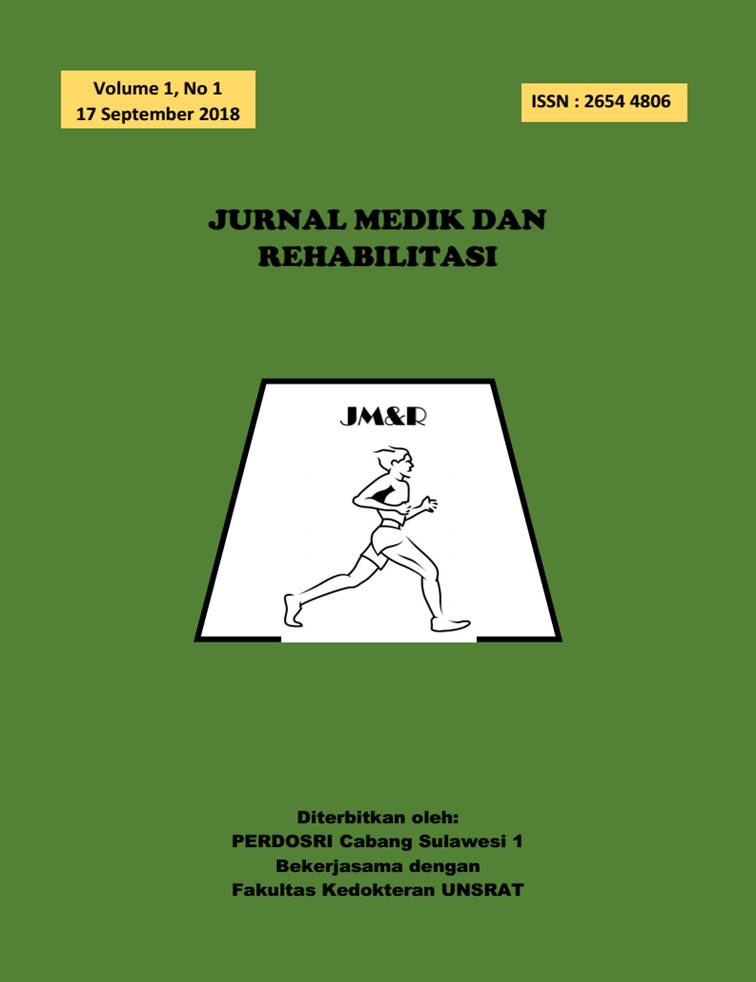REHABILITASI MEDIK PADA PASIEN DENGAN CERVICAL DYSTONIA
Abstract
Abstract
Cervical Dystonia (CD) is the most common focal dystonia, involves the sternocleidomastoid, trapezius, and posterior cervical muscles. It gives rise to patterned, repetitive, and spasmodic movement that causes the head to twist (rotational torticollis), extend (retrocollis), flex (anterocollis), or tilt toward the shoulder (laterocollis) often associated with reduced range of motion (ROM) in the direction contralateral to the movement. One or more of these head movements may occur simultaneously.1Horizontal rotation is the most common abnormal movement, present approximately 80% of patients. Walking or standing worsens the condition, but the patient may be able to return the head to midline by placing the hand on the jaw or chin (sensory trick). The physiologic mechanism of sensory tricks remains unknown.2,3
Every CD case is unique, and therefore the rehabilitation approach must take into account the specific clinical presentation.2 As the aim is to obtain stability of the head on midline, the physiatrist develops an approach to treatment with realistic steps to be reached within a reasonable time frame. For some patients, treatment of pain is the priority, whereas for others it is stiffness of the neck or reawakening of specific muscles. Pain is often reduced by stretching the muscles concerned and by careful mobilization of the painful joints. Electrotherapy , in particular ultrasound therapy, is used for its thermic, vasomotor, and,fibrolytic properties. Once the head is well positioned, one deals with the compensatory attitude of the upper body. The torso and shoulder girdle are frequently involved in the pathologic posture. Regular assessments allow the treatment to be constantly reshaped to fit the clinical evolution.4
Rehabilitation must help patients carry out activities essential to daily life, such as moving around independently, dressing, eating independently, and meeting basic hygiene requirements. Rehabilitation treatment must enable the reinsertion of patients with CD into family, social, and professional life as well as help them find within themselves a new dignity to their lives.5
Keywords: Cervical Dystonia, spasmodic movement, torticollis
Â
Abstrak
Cervical Dystonia (CD)Â adalah distonia fokal yang paling umum, melibatkan sternocleidomastoid, trapezius, dan otot cervical posterior. Ini menimbulkan gerakan berpola, berulang, dan spasmodik yang menyebabkan kepala berputar (tortikolis rotasi), memperpanjang (retrocollis), fleksi (anterocollis), atau miring ke arah bahu (laterocollis) sering dikaitkan dengan pengurangan lingkup gerak sendi (LGS) ke arah kontralateral ke gerakan. Satu atau lebih dari gerakan-gerakan kepala ini dapat terjadi secara bersamaan. Rotasi horizontal adalah gerakan abnormal yang paling umum, menyajikan sekitar 80% pasien. Berjalan atau berdiri memperburuk kondisi, tetapi pasien mungkin dapat mengembalikan kepala ke garis tengah dengan meletakkan tangan di rahang atau dagu (trik sensorik). Mekanisme fisiologis dari trik-trik sensorik masih belum diketahui.2,3
Setiap kasus ST adalah unik, dan karena itu pendekatan rehabilitasi harus mempertimbangkan presentasi klinis spesifik. 2 Tujuannya adalah untuk mendapatkan stabilitas kepala di garis tengah, ahli fisioterapi mengembangkan pendekatan untuk pengobatan dengan langkah-langkah realistis untuk dicapai dalam jangka waktu yang wajar. Untuk beberapa pasien, pengobatan nyeri adalah prioritas, sedangkan untuk yang lain itu adalah kekakuan leher atau kebangkitan kembali otot-otot tertentu. Nyeri sering dikurangi dengan peregangan otot-otot yang bersangkutan dan dengan hati-hati mobilisasi sendi yang menyakitkan. Elektroterapi, khususnya terapi ultrasound, berguna untuk sifat termik, vasomotor, dan fibrolytic. Setelah kepala diposisikan dengan baik, sikap kompensasi dari tubuh bagian atas juga harus diperbaiki. Batang tubuh dan bahu sering terlibat dalam postur patologis..4
Rehabilitasi harus membantu pasien melakukan kegiatan yang penting untuk kehidupan sehari-hari, seperti bergerak secara mandiri, berpakaian, makan secara mandiri, dan memenuhi persyaratan kebersihan dasar. Perawatan rehabilitasi harus memungkinkan masuknya pasien dengan ST ke dalam kehidupan keluarga, sosial, dan profesional serta membantu mereka menemukan dalam diri mereka martabat baru untuk kehidupan mereka.5
Â
Kata kunci: Distonia cervical, gerakan spasmodic, torticolis
References
Ron Hirschberg, 2010. Cervical Dystonia. In DeLisa’s Physical Medicine and Rehabilitation Principles and Practice. 5th edition. Philadelpia : Lippincott Williams & Wilkins, pp. 657-660.
Cynthia L Comella, 2007. Cervical Dystonia. In Clinical Diagnosis and Management of Dystonia. 1st edition. United Kingdom : Informa Health Care, pp. 73-77.
Francois Hains, DC et al, Cervical Dystonia : A Case Study : A Journal of the CCA,Vol. 36, No. 3, 1992.
Bogey RA, Elovic EP, Bryant PR, Geis CC, Moroz A,O’Neill BJ. Rehabilitation of movement disorders. Arch Phys Med Rehabil 2004; 85 Suppl 1: S41-S45.
Donna Page, MSc et al, 2007. Quality of Life in Focal, Segmental, and Generalized Dystonia : A Journal of Movement Disorder, Vol. 22, No. 3, 2007, pp. 341–347.
Slawek J, Friedman A, Potulska A et al, 2007. Factors affecting the health-related quality of life of patients with cervical dystonia and the impact of botulinum toxin type A injections. Funct Neurol 2007; 22: 95-100.
Claire M.Gudex, MB ChB et al, 1998. Effect of Dystonia and Botulinum Toxin Treatment on Health-Related Quality of Life : A Journal of Movement Disorder, Vol. 13,No. 6, 1998, pp.941-946.
Arja Ha¨kkinen, PhD et al, 2004. Decreased Neck Muscle Strength Is Highly Associated With Pain in Cervical Dystonia Patients Treated With Botulinum Toxin Injections : A Journal of Arch Phys Med Rehabil Vol 85, October 2004.
Van Den Dool et al, 2013. Cervical Dystonia effectiveness of a standardized physical therapy program; study design and protocol of a single blind randomized controlled trial : The journal of BMC Neurology 2013, 13:85

